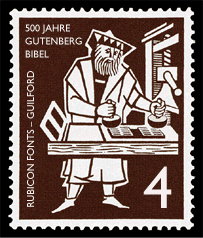|
Movable
type
celebrates
570
years
 Johannes Gutenberg spreads ink on his printing press, circa 1440. The lettering in the image is set in Guilford, a design which retains some medieval qualities. References Adobe: Comp.fonts FAQ: |
|
During the period 1991 to 1998 Rubicon produced a number of font clones. There were many small companies doing this but we survived because our font clones were digitised accurately at high resolution and were better quality than most. In the USA typefaces and bitmapped fonts are not copyrightable but scalable fonts are. Anyone with sufficient time and skill can make an original representation of a typeface as a scalable font and copyright it. For information on font copyright laws in the USA and elsewhere refer to the links at the left or consult a lawyer. In 1991–1992 we produced a series of fonts based on the Computer Modern designs from TEX and Metafont. These brought critical acclaim but not much revenue. The look of the Computer Modern fonts was not mainstream. We provided some of these fonts as demo fonts for Fontographer 3.5. In 1993–1994 we produced a series of fonts based on popular designs like Garamond, Frutiger, Kabel, and Optima. This was successful until 1997 when companies like Microsoft, Corel, Adobe, and Apple started bundling high quality fonts with their software. In 1995–1996 we produced a series of fonts that emulated the base fonts of Postscript and PCL laser printers. For Postscript printers this was Times and Helvetica and for PCL printers this was CGTimes and Univers. This turned out to be a great idea because it meant that you could print documents that looked like they came from an Apple LaserWriter or Hewlett-Packard LaserJet on a much cheaper printer. We also added Light and Extrabold weights as well as Condensed weights to several of our popular fonts. In 1997–1998 we produced some decorative fonts and a series of fonts based on the designs of Gill Sans and Helvetica Neue. At the end of 1998 we decided it was no longer beneficial to produce font clones. Instead, we decided to maintain and improving our existing fonts, concentrating on adding better hinting and producing better TrueType versions. CSS3 changes fonts and typography on the web In 1996, Microsoft released Core fonts for the web. They were the only fonts available on web sites. Later attempts to support custom fonts in web browsers were not successful, so the variety of fonts on the web has been limited. CSS3 Fonts Module Level 3 changes this by introducing web fonts and providing web designers with greater typographical control. The CSS3 enhancements are mapped out into a series of stages and browser developers are slowly implementing them. The first stage is CSS 2.1 and there have been some stumbling blocks getting there. Microsoft included support for web fonts in Internet Explorer 4.0 in September, 1997 but it was not successful. They used a proprietary font format called Embedded Open Type (EOT). Other browsers did not support EOT, the tools for coverting fonts to EOT were problematic, and font vendors didn't want to allow these conversions. Working draft 2 of the CSS Fonts Module was completed in August, 2002, but the first browser to implement web fonts was Mozilla Firefox 3.5 in June, 2009. Firefox supported web fonts in SVG and TTF formats, but not EOT. Other browsers followed suit including Google Chrome and Apple Safari, but Microsoft did not. Now there were problems with web font formats. Internet Explorer required EOT format. SVG format lacked hinting, so the fonts didn't always look good on screen. Finally, font vendors did not want to allow their TTF fonts to be used as web fonts, because it makes them very easy to steal. In April, 2010, Mozilla, Opera Software, and Microsoft submitted specifications for a new format for web fonts called Web Open Font Format which is now supported by all major browsers, including Firefox 3.6, Chrome 6, Opera 11, Safari 5.1, and Internet Explorer 9. This means that all current major browsers support WOFF, though in practice you have to provide EOT fonts as well, for users of Internet Explorer 7 and 8. |
Rubicon adds web fonts in WOFF and EOT
formats Rubicon font sets are now available in WOFF and EOT web font formats. The cost is US$12 per font set, which includes both formats and a web hosting licence for a single domain or intranet. We do not licence our fonts in desktop font formats for use as web fonts. Support for web fonts among various browsers is not uniform, but most browsers support either WOFF or EOT. By including both formats on your web site, you can create web pages that incorporate custom web fonts and are compatible with most browsers. Computers use digital font technologies in three different ways as described below. This helps users share textual information. Custom fonts that are not built in to operating systems and devices need to be added and shared. In Print. Users print their documents and share the printed copies. Custom fonts are installed only on the author's computer. On Screen. Users read and share electronic documents on-screen, with printing as an option. Custom fonts are installed on the author's computer and also embedded in the documents. Document formats that support font embedding include Microsoft Word and Adobe Acrobat. Over the web. Users browse web pages 0n-screen, with printing as an option. Custom fonts are installed on the author's computer and also hosted on internet as web fonts. |
| Updated Sept. 29,
2011 |